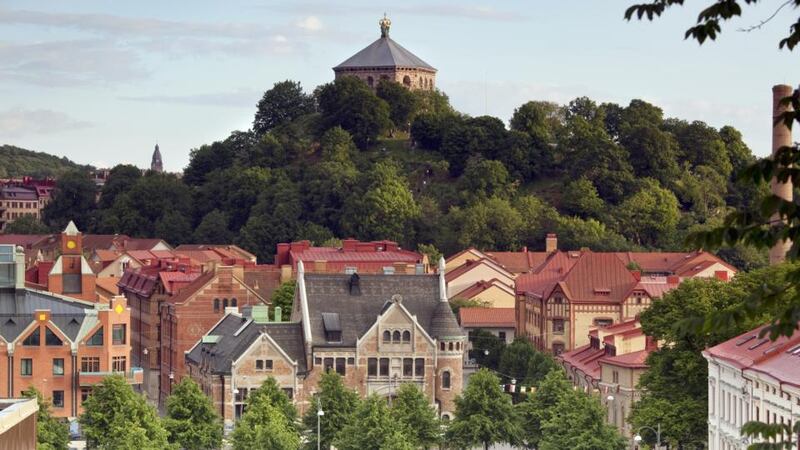G ive me a second city any day. They’re funnier and more friendly than a glossy and poised capital. Self-deprecation is the schtick of Gothenburg, or Göteborg, Sweden’s second city. You’ll see it in the umbrella vending machine at the airport. Welcome to Gothenburg: You’re going to get rained on.
In the end, we don’t. On the second day, warm sun shines on the ghostly outline of the capital “D” on the side of an enormous floating dock in Gothenburg harbour. The gargantuan piece of kit is for sale following the collapse of the shipbuilding industry. Here lies Sweden’s shipbuilding past.
Further down there's a Stena express ship also for sale, its fueltoo expensive to compete on the fast ferry route. Then there's The Viking, a tall ship that has never left the harbour because its 55m mast can't pass under the 45m bridge built after the tall ship was delivered.

You have to love a place that turns its floating white elephants into tour nuggets. And water, be it sea or canals, never feels far away in this part of western Sweden.
I’m on a press trip organised by SAS, which has begun a summer direct flight from Dublin to Gothenburg. We’re on the Paddan boat tour, puttering around the city’s canals, some of which were once part of the moat, and out into its vast harbour, Sweden’s largest.
Anika, our brilliant young guide, is hamming it up shamelessly. She points out “the Eiffel Tower of Gothenburg” – a hideous red and white 1980s office block the locals call the Lipstick. There are the remains of the lowest bridge (“We called it the cheese slicer”), which was demolished to let the boats through. There’s another bridge called the hairdresser, which requires a collective duck for decapitation-free passage.
We pass by the banana pier, built in the 1940s to take Sweden’s first delivery of bananas. Crowds gathered. “You could almost say they went bananas,” Anika says to groans. Sweden is still nuts for bananas along with its puns. The average Swede eats 20kg of bananas a year.
Food is a large part of Gothenburg’s history. Tea, spices and silk were at the heart of the Swedish East India Company, whose 18th-century warehouse is now the city’s main museum. The return sea voyage to China took 18 months, with one in four crew members dying at sea on average.
Back on dry land, Gothenburg is hipster heaven, a lovely, walkable expanse of vintage shopping, food trucking and craft beering, interspersed with regular stops for fika.
Sofie Mantzaris, press officer with Gothenburg’s tourist board explains that fika isn’t just cake and coffee. “It’s not a lone thing. You can only do it with somebody. If you’re on your own, it’s a coffee break. If you’re with friends or colleagues, it’s fika.”
Matts Johansson has brought the Swedish coffee scene out of the cup-of-tar world and into complex drip blends, hand-roasted in his chain of four de Matteo coffee shops. We bump into him in the largest one, where sacks of green Colombian beans wait to go into the roaster.
Markus, Matts’s barista, serves us a blend that he sells as “a gateway towards what we’d really like you to like” – in other words a more acidic or bitter coffee. Only bad coffee needs milk, Matts tells us. And that bite of cinnamon bun? It will kill the subtle flavours of the coffee. He’s right, but, with cake this delicious, I don’t care. The cardamom version is even better.
Then we’re off to catch one of the blue and white trams that rattle round Gothenburg at a fair lick. The swampy ground under the city is too wet for an underground system. This journey is going to take us from the centre to the coast and onward, 15 minutes by boat, to the island of Styrsö.
Island hopping is a big part of summer life in Sweden. But to do it you probably need to know a friend with a boat and a summer house, Sofie explains. Here you can join the city daytrippers to the archipelago and jump off a dock to swim to a rocky outcrop if you fancy.
A population of 1,500 lives on Styrsö, a car-free island. Instead, there are golf carts and Fargo-esque three-wheel mopeds with pallets welded to the front to carry everything from children in all-in one rain suits to DIY equipment to spouses. You get used to the whine of the two-stroke engine as you pedal around.
Our bikes are on loan from Styrsö Skäret, the main guesthouse on the island. After a two-hour pedal, the first half of which is spent mastering the back-pedal brake, we're ready for the great food served by the couple who own it, Ylva and Ola Tulldahl. Ola meets us and explains how they try to do something new once a year. He's got a folding wooden ruler in his back pocket, having taken a break from installing a new floor.
“We want it to be like your grandma’s place,” he says. “Where you can just relax and do nothing and get spoiled.” The 13-bedroom guesthouse is stuffed with bric-a-brac, from binoculars to chintz fireside armchairs and the ever-flickering candles that go into creating cosiness, something that’s another national obsession.
Back in the city on the last day, a stroll through Haga district is fuelled by Swedish street food from Strömmingsluckan. The food truck is one of several in a square off Magasingatan. A carton of fried herring, buttery mash and lingonberry jam will cost you 60 krona (about €6.50).
In a city of biggests (biggest port, biggest shopping mall, biggest amusement park at Liseberg) we stumble across the quirkiest biggest at Cafe Husaren on Haga Nygata. Here the cinnamon buns are the size of dinner plates. They can only be for that very Swedish tradition: fika with friends.

















